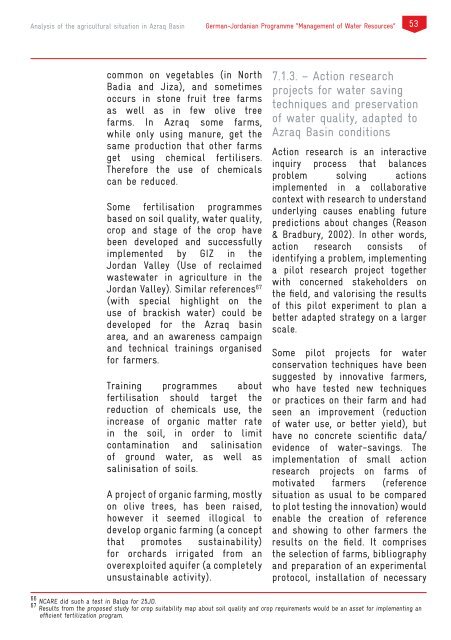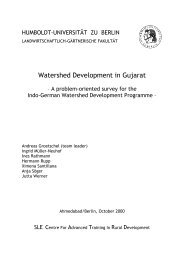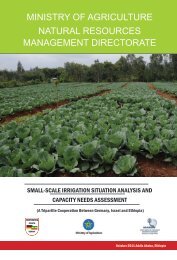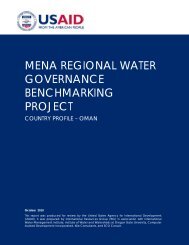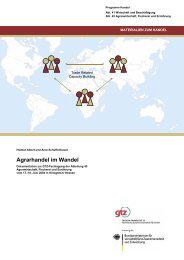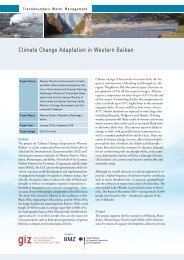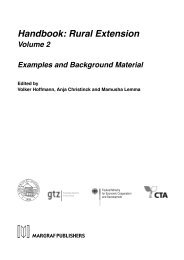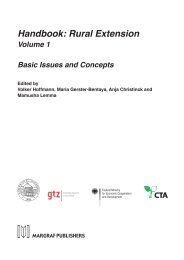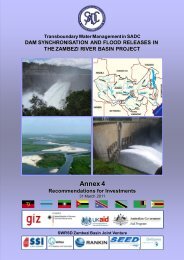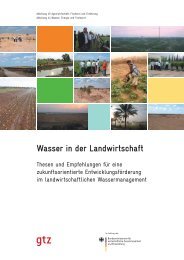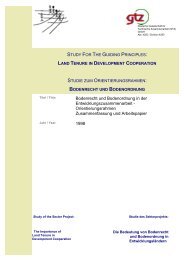Farming in the - WordPress.com
Farming in the - WordPress.com
Farming in the - WordPress.com
You also want an ePaper? Increase the reach of your titles
YUMPU automatically turns print PDFs into web optimized ePapers that Google loves.
Analysis of <strong>the</strong> agricultural situation <strong>in</strong> Azraq Bas<strong>in</strong><br />
German-Jordanian Programme “Management of Water Resources”<br />
53<br />
<strong>com</strong>mon on vegetables (<strong>in</strong> North<br />
Badia and Jiza), and sometimes<br />
occurs <strong>in</strong> stone fruit tree farms<br />
as well as <strong>in</strong> few olive tree<br />
farms. In Azraq some farms,<br />
while only us<strong>in</strong>g manure, get <strong>the</strong><br />
same production that o<strong>the</strong>r farms<br />
get us<strong>in</strong>g chemical fertilisers.<br />
Therefore <strong>the</strong> use of chemicals<br />
can be reduced.<br />
Some fertilisation programmes<br />
based on soil quality, water quality,<br />
crop and stage of <strong>the</strong> crop have<br />
been developed and successfully<br />
implemented by GIZ <strong>in</strong> <strong>the</strong><br />
Jordan Valley (Use of reclaimed<br />
wastewater <strong>in</strong> agriculture <strong>in</strong> <strong>the</strong><br />
Jordan Valley). Similar references 67<br />
(with special highlight on <strong>the</strong><br />
use of brackish water) could be<br />
developed for <strong>the</strong> Azraq bas<strong>in</strong><br />
area, and an awareness campaign<br />
and technical tra<strong>in</strong><strong>in</strong>gs organised<br />
for farmers.<br />
Tra<strong>in</strong><strong>in</strong>g programmes about<br />
fertilisation should target <strong>the</strong><br />
reduction of chemicals use, <strong>the</strong><br />
<strong>in</strong>crease of organic matter rate<br />
<strong>in</strong> <strong>the</strong> soil, <strong>in</strong> order to limit<br />
contam<strong>in</strong>ation and sal<strong>in</strong>isation<br />
of ground water, as well as<br />
sal<strong>in</strong>isation of soils.<br />
A project of organic farm<strong>in</strong>g, mostly<br />
on olive trees, has been raised,<br />
however it seemed illogical to<br />
develop organic farm<strong>in</strong>g (a concept<br />
that promotes susta<strong>in</strong>ability)<br />
for orchards irrigated from an<br />
overexploited aquifer (a <strong>com</strong>pletely<br />
unsusta<strong>in</strong>able activity).<br />
7.1.3. – Action research<br />
projects for water sav<strong>in</strong>g<br />
techniques and preservation<br />
of water quality, adapted to<br />
Azraq Bas<strong>in</strong> conditions<br />
Action research is an <strong>in</strong>teractive<br />
<strong>in</strong>quiry process that balances<br />
problem solv<strong>in</strong>g actions<br />
implemented <strong>in</strong> a collaborative<br />
context with research to understand<br />
underly<strong>in</strong>g causes enabl<strong>in</strong>g future<br />
predictions about changes (Reason<br />
& Bradbury, 2002). In o<strong>the</strong>r words,<br />
action research consists of<br />
identify<strong>in</strong>g a problem, implement<strong>in</strong>g<br />
a pilot research project toge<strong>the</strong>r<br />
with concerned stakeholders on<br />
<strong>the</strong> field, and valoris<strong>in</strong>g <strong>the</strong> results<br />
of this pilot experiment to plan a<br />
better adapted strategy on a larger<br />
scale.<br />
Some pilot projects for water<br />
conservation techniques have been<br />
suggested by <strong>in</strong>novative farmers,<br />
who have tested new techniques<br />
or practices on <strong>the</strong>ir farm and had<br />
seen an improvement (reduction<br />
of water use, or better yield), but<br />
have no concrete scientific data/<br />
evidence of water-sav<strong>in</strong>gs. The<br />
implementation of small action<br />
research projects on farms of<br />
motivated farmers (reference<br />
situation as usual to be <strong>com</strong>pared<br />
to plot test<strong>in</strong>g <strong>the</strong> <strong>in</strong>novation) would<br />
enable <strong>the</strong> creation of reference<br />
and show<strong>in</strong>g to o<strong>the</strong>r farmers <strong>the</strong><br />
results on <strong>the</strong> field. It <strong>com</strong>prises<br />
<strong>the</strong> selection of farms, bibliography<br />
and preparation of an experimental<br />
protocol, <strong>in</strong>stallation of necessary<br />
66 NCARE did such a test <strong>in</strong> Balqa for 25JD.<br />
67 Results from <strong>the</strong> proposed study for crop suitability map about soil quality and crop requirements would be an asset for implement<strong>in</strong>g an<br />
efficient fertilization program.


